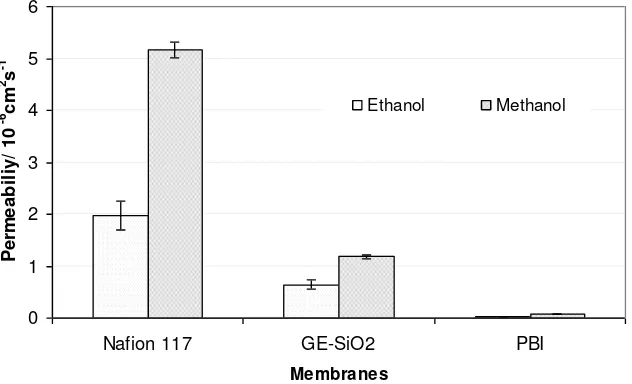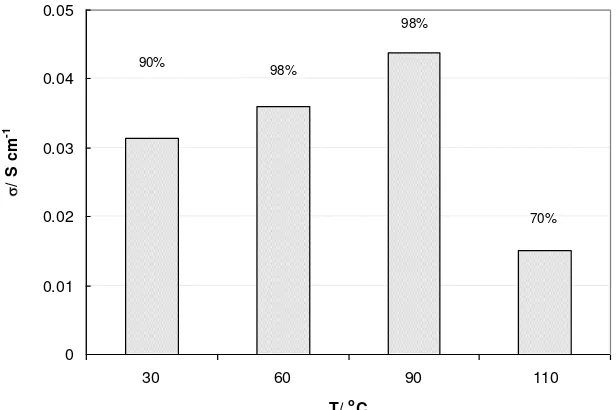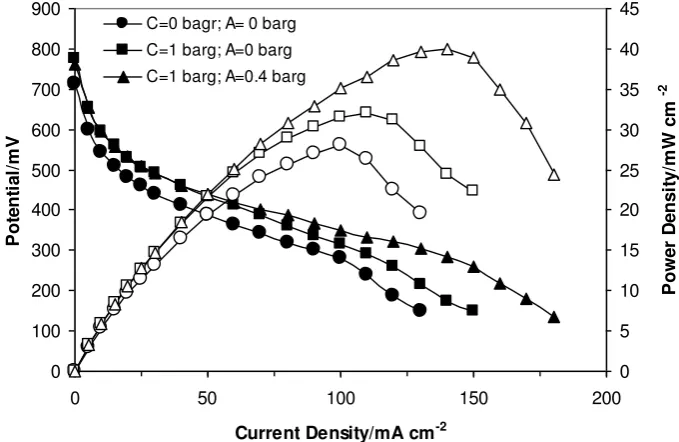A DIRECT ETHANOL FUEL CELL OPERATING
AT INTERMEDIATE TEMPERATURE (100-200
OC)
Nur Hidayati* and Keith Scott**
*Department of Chemical Engineering, Muhammadiyah University of Surakarta,
Surakarta, Indonesia
Telp.: +62 271 717417; E-mail address: [email protected]
**School of Chemical Engineering and Advanced Materials, Newcastle University,
Newcastle upon Tyne, United Kingdom
Abstract
Even though investigations regarding DEFC have existed for a few years, there remain problems in terms of efficiency and ethanol crossover. It is considered that the electro-oxidation reaction of ethanol must be complete, involving the release of 12 electrons per ethanol molecule and the breaking of C-C bonds for recovering the maximum energy, that is, it must lead to CO2. The
increasing reaction temperature can enhance the cell performance because thermal activation of electro-chemical reaction is pronounced and operating at higher temperature reduces the adsorbed CO species. The obstacle to increasing temperature is the limitation of the most commonly used Nafion® membrane. The dependence on its water content limits the working temperature (< 100 oC). Commercial PBI and Nafion-silica membranes were sandwiched in between electrodes prepared using commercial catalysts, carbon supported platinum and platinum-tin as cathode and anode catalysts respectively. The MEAs were tested at temperature of 100-200oC in the single cell. Both membranes could work at operating temperature of 100-200oC. However based-PFSA membranes still needed wet condition to reach better performance. On the other hand, performance of single cell using PBI membrane at dry system was quite comparable with that of single cell using Nafion-silica membrane.
Keywords: composite Nafion® membrane, PBI, DEFC
1. Introduction
One limitation of the DEFC is the relatively poor kinetic performance of anode electro-catalysts at low temperature (< 100 oC). The operation of fuel cells at higher temperature can increase the kinetics of ethanol oxidation and reduce adsorption of intermediates on the anode catalyst acting as poisoning materials. However, a typical membrane for DEFC, a perfluorosulphonated membrane of Nafion®, usually dehydrates at high temperature and leads to high ohmic losses and poor performance. Another restriction is that Nafion® suffers from high ethanol permeability due to the solvated protons going through the water filled ion cluster channels (Ren et al., 2000). Such ethanol permeability (crossover) leads to reduced activity of the oxygen reduction reaction. The development of proton conduction membranes with mechanical and chemical stability at high temperature with minimum ethanol crossover is a potential route to produce economical DEFCs.
This work presents the results of characterisation of Golden Energy-SiO2 (GE-SiO2) and PBI membranes.
Performance in single fuel cell tests was also investigated at temperatures of 100-200 oC and compared with the use of a commercial membrane (Golden Energy-SiO2) and PBI.
2. Experimental Water Uptake
The membrane water uptake was measured in water at room temperature. It was calculated from the difference in weight between wet and dry samples. The wet weight was determined after immersion of the samples in the water at room temperature for 48 hours. Subsequently, the membrane surfaces were wiped with a tissue paper and weighed immediately. To obtain the dry weight, the samples were heated in an oven at 120 oC for 2 hours.
The water uptake was determined from:
Where WUT, mwet, and mdry represented water up take by weight (w.%), and weight of wet and dry membranes,
respectively.
Permeability Measurements
Ethanol permeability was measured with a two-compartment glass cell. One compartment was filled with 100 cm3 of 3 mol cm-3 ethanol solution and the other was filled with 100 dm3 of deionised water. The membrane was clamped between two compartments. Solutions in each compartment were stirred continuously during measurement. Ethanol concentration in the receiving compartment was measured as a function of time by measuring the refractive index of a 0.5 cm3 sample from each compartment. The observed refractive index was compared to the corresponding value of the calibration curve.
Conductivity Measurements
The membrane conductivity was measured using the four probe technique. The cell was equipped with four platinum foils. The distance between foils was 5 mm. The membranes were cut into 4 x 1 cm strips and positioned across four platinum foils. Current was fed to the membranes by two platinum foils. The other two foils were used to measure the potential drop along the membranes. AC impedance was performed in the
Where is the ionic conductivity, l is the distance between the electrodes, R is the resistance of the membrane, and A is the cross-sectional area.
Fuel Cell Test
Single cell tests were performed with a cell made of titanium having a cross-sectional area of 1 x 1 cm gold coated parallel flow field. Mica filled PTFE was used to border the flow field. An isolated platinum wire connected to the edge of the flow fields acted as a current collector and was put under the mica sheet. The cell temperature was controlled by a thermostat and 3 cartridge heaters were inserted into the cell body.
The performance of the single cell was evaluated by measuring current potential (I-E) characteristic of the MEA using an electronic load (Kenwood PEL 151-201) at a fixed temperature. The MEA was fixed between two flow distribution plates and heated to the required temperature. The single cell was fed with distilled water for about 24 hours to humidify the components. Then the anode was fed with ethanol solution and the cathode was oxygenated for overnight before polarization measurements. The temperature of fuel to the cell was controlled in a heating pipe.
3. Result and Discussions Water uptake
Water uptake is an important characteristic of a membrane as it provides information on the water retention ability of the membrane. Hydration of a membrane affects its conductivity, mechanical stability, and fuel permeability (Jiang et al., 2006 and Saccà et al., 2006). The water uptake properties of prepared membranes and commercial Nafion® 117 and GE-SiO2 are listed in Table 1. It is shown that composite membranes have
higher water uptake (37 w.%) than the Nafion 117 (25 w.%), which specifies the ability to adsorb more water. An increased water uptake by GE-SiO2 membranes is due to the hygroscopic affinity of silica and its high
water-absorption capacity (Kreuer, 1996 and Kim et al., 2009).
Table 1 The water uptake behaviour of Nafion 117 and GE-SiO2 membranes at room temperature.
expected, GE-SiO2 and PBI membranes allow lower ethanol and methanol permeability than Nafion®117 with
the order PBI<GE-SiO2<Nafion®117; although Nafion®117 (175 m) is thicker than others. The presence of
silica in ion cluster pores acts as a barrier for ethanol and methanol transport; hence, it reduces ethanol and methanol permeability. Pu et al. (2004) suggested that methanol easily forms a hydrogen bond with PBI compared to Nafion®, which blocks methanol transport through the PBI membrane.
Another observation is that ethanol has a lower permeability value through all membranes than methanol. A similar trend of ethanol and methanol permeability through Nafion® 117 was observed by Xue et al. (2007), with values of 1.48 x 10-6 and 1.7 x 10-6 cm2 s-1 for ethanol and methanol, respectively.
Fig. 1 Permeability of Nafion® 117, commercial GE-SiO2 and PBI membranes at room temperature.
Conductivity
Conductivity of GE-SiO2 measured at 30 – 110 oC under 70 - 100 % relative humidity (RH) is shown in
Fig. 2. As temperature increases up to 90 oC the proton conductivity of the composite membrane improves progressively from 0.03 to 0.045 S cm-1. These results agree with those reported by the groups of Jiang (2006) and Tominaga (2007). A reduction in conductivity occurred when the temperature increased to 110 oC and relative humidity decreased to 70 %. Yuan et al. (2008) also observed a similar trend with Nafion® hollow silica sphere membranes; the conductivity decreased quickly when temperature increased above 100 oC. The decrease in conductivity is due to water loss from the membranes through evaporation. The reported conductivity of Nafion® 117 is 0.013 S cm-1 (Smitha et al., 2005) under the same condition (lower than that of GE-SiO2) .This is
due to the higher ability of composite membrane to take water up.
0 0.01 0.02 0.03 0.04 0.05
30 60 90 110
T/ oC
/
S
c
m
-1
90%
98%
98%
70%
Fig. 2 Conductivity of commercial GE-SiO2 membrane at varied temperature.
Fig. 3 Conductivity of PBI membrane at varied temperature and relative humidity (Scott et al., 2007).
Fuel Cell Test
0
Fig. 4 Polarisation curves of DEFC with commercial Nafion®117 and GE-SiO2 membrane operated at 110 o
C and pressures of anode and cathode; 1 and 0.4 barg respectively. Anode: PtSn/C (2 mg Pt cm-2), 2 mol dm-3 ethanol. Cathode: Pt/C (1 mg Pt cm-2), unhumidified O2.
The effect of anode and cathode pressure on polarisation at 110 oC is shown in Fig. 5 and Table 2. Increasing pressure at the cathode from ambient pressure to 1 barg considerably improved the OCV from 565 to 754 mV. Although an increase in pressure to 0.4 barg at the anode led to a decrease of OCV from 754 to 723 mV, the power density nearly doubled. This is due to an improvement in behaviour in the ohmic controlled region caused by an increase in conductivity and a reduction in mass transport. A significant power density improvement to 98 mW cm-2 occurred when anode pressure increased steadily from 0 to 0.8 barg. It is suggested that an increased anode pressure had a positive influence on the anode kinetics and reduced fuel vaporisation, hence a liquid feed led to maintaining membrane water uptake and reducing mass transport limitation at a high current density, whilst an increased cathode pressure increased cathode kinetics and reduced crossover. Similar results for the polarisation of composite Nafion® DFMC performance were observed by Arico et al. (2003); operating pressure influenced the reaction kinetics, membrane hydration, and mass transport at high current density.
0
Fig. 5 Polarisation and power density curves of DEFC with commercial GE-SiO2 membrane operated at 110 oC and different pressures of anode and cathode. Anode: PtSn/C (2 mg Pt cm-2), 2 mol dm-3 ethanol. Cathode: Pt/C (1 mg Pt cm-2), unhumidified O2.
0 temperature and atmospheric pressure at anode and cathode. Anode: PtSn/C (1 mg Pt cm-2), 2 mol dm-3 ethanol. Cathode: Pt/C (1 mg Pt cm-2), unhumidified O2.
Figure 7 shows polarisation and power density curves with the pressure effect at 175 oC. An increase in pressure at the cathode improves the OCV and power density. Oxygen reduction is accelerated kinetically with pressure and produces more water. The water produced at the cathode side humidifies the membrane through the back-transport process from the cathode to the anode, thus affecting the ionic conductivity of the membrane Daletou et al., 2009). Penetration of oxygen from the cathode may reduce the crossover effect, and hence the OCV increases.
There was a 15 mV reduction in the OCV, from 775 mV, when the anode pressure increased to 0.4 barg from the atmospheric pressure. Anode pressure led to higher crossover. On the other hand, the partial pressure of ethanol increased with increasing pressure, thus promoting a kinetically anode reaction which caused condensation of the vapour feed; thus, liquid feed affected the membrane conductivity. Less potential losses in the ohmic controlled region may be due to an increase in membrane conductivity.
4. Conclusion
The better performance of DEFC with a composite membrane at a working temperature of 110 oC was due to higher membrane water uptake, leading to higher proton conductivity. Operation at high anode pressure showed significant improvement. This was due to the increase of liquid fraction in the system, which increased the membrane conductivity.
The PBI-based DEFC operating at 125, 150, and 175 oC performed with a vapour feed. The temperature and pressure enhanced the cell performance because of improvements in electrode kinetics and PBI conductivity.
5. References
Ren, X.; Springer, T. E.; Zawodzinski, T. A.; Gottesfeld, S., (2000), “Methanol Transport Through Nation Membranes. Electro-osmotic Drag Effects on Potential Step Measurements”, Journal of The Electrochemical Society , 147, (2), 466-474.
Jiang, R.; Kunz, H. R.; Fenton, J. M., (2006), “Composite silica/Nafion® membranes prepared by tetraethylorthosilicate sol-gel reaction and solution casting for direct methanol fuel cells”,Journal of Membrane Science, 272, (1-2), 116-124.
Saccà, A.; Carbone, A.; Pedicini, R.; Portale, G.; D'Ilario, L.; Longo, A.; Martorana, A.; Passalacqua, E., (2006),
“Structural and electrochemical investigation on re-cast Nafion membranes for polymer electrolyte fuel cells
(PEFCs) application”,Journal of Membrane Science 278, (1-2), 105-113.
Kreuer, K.-D., (1996), “Proton Conductivity: Materials and Applications. Chemistry of Materials”,, 8, (3),
610-641.
Kim, Y. J.; Choi, W. C.; Woo, S. I.; Hong, W. H., (2004), “Proton conductivity and methanol permeation in Nafion(TM)/ORMOSIL prepared with various organic silanes”,Journal of Membrane Science, 238, (1-2),
213-222.
Li, T.; Yang, Y., (2009), “A novel inorganic/organic composite membrane tailored by various organic silane coupling agents for use in direct methanol fuel cells”,Journal of Power Sources , 187, (2), 332-340.
Li, C.; Sun, G.; Ren, S.; Liu, J.; Wang, Q.; Wu, Z.; Sun, H.; Jin, W., (2006), “Casting Nafion-sulfonated organosilica nano-composite membranes used in direct methanol fuel cells”,Journal of Membrane Science, 272,
(1-2), 50-57.
Pu, H.; Liu, Q.; Liu, G., (2004), “Methanol permeation and proton conductivity of acid-doped poly(N-ethylbenzimidazole) and poly(N-mpoly(N-ethylbenzimidazole)”,Journal of Membrane Science, 241, (2), 169-175.
Xue, S.; Yin, G.; Cai, K.; Shao, Y., (2007), “Permeabilities of methanol, ethanol and dimethyl ether in new composite membranes: A comparison with Nafion membranes”, Journal of Membrane Science, 289, (1-2),
51-57.
Tominaga, Y.; Hong, I.-C.; Asai, S.; Sumita, M., (2007), “Proton conduction in Nafion composite membranes filled with mesoporous silica”,Journal of Power Sources , 171, (2), 530-534.
Yuan, J.; Zhou, G.; Pu, H., (2008), “Preparation and properties of Nafion®/hollow silica spheres composite membranes”,Journal of Membrane Science, 325, (2), 742-748.
Smitha, B.; Sridhar, S.; Khan, A. A.,(2005), “Solid polymer electrolyte membranes for fuel cell applications--a review”,Journal of Membrane Science, 259, (1-2), 10-26.
Aricò, A. S.; Baglio, V.; Di Blasi, A.; Creti, P.; Antonucci, P. L.; Antonucci, V., (2003), “ Influence of the acid-base characteristics of inorganic fillers on the high temperature performance of composite membranes in direct methanol fuel cells”,Solid State Ionics, 161, (3-4), 251-265.
Lobato, J.; Cañizares, P.; Rodrigo, M. A.; Linares, J. J.; LoÌ• pez-VizcaiÌ• no, R. n., (2008), “Performance of
a Vapor-Fed Polybenzimidazole (PBI)-Based Direct Methanol Fuel Cell”,Energy & Fuels, 22, (5), 3335-3345.
Lobato, J.; Cañizares, P.; Rodrigo, M. A.; Linares, J. J., (2009), “Testing a Vapour-fed PBI-based Direct Ethanol Fuel Cell”,Fuel Cells, 9, (5), 597-604.
Wang, J.; Wasmus, S.; Savinell, R. F., (1995), “Evaluation of Ethanol, 1-Propanol, and 2-Propanol in a Direct Oxidation Polymer-Electrolyte Fuel Cell”,Journal of The Electrochemical Society, 142, (12), 4218-4224.
Daletou, M. K.; Kallitsis, J. K.; Voyiatzis, G.; Neophytides, S. G., (2009), “The interaction of water vapors with H3PO4 imbibed electrolyte based on PBI/polysulfone copolymer blends”, Journal of Membrane Science, 326,




